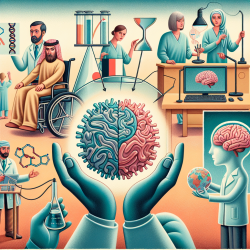Introduction
In the realm of speech-language pathology, understanding the neurological underpinnings of speech and language disorders is crucial. Recent research has identified the potential of cerebrospinal fluid (CSF) biomarkers in reflecting brain processes, providing insights into conditions such as ischemic stroke and neurodegenerative diseases. A study titled "Transient increase in CSF GAP-43 concentration after ischemic stroke" sheds light on the role of Growth-Associated Protein 43 (GAP-43) in the aftermath of a stroke, offering valuable implications for practitioners.
Understanding GAP-43 and Its Role
GAP-43 is a presynaptic protein involved in neuronal development, synaptogenesis, and synaptic plasticity. It is notably upregulated in brain tissue shortly after ischemic events, suggesting its potential as a biomarker for ischemic brain disorders. The study in question analyzed CSF GAP-43 concentrations in stroke patients, revealing significant findings that can enhance clinical practice.
Key Findings
- CSF GAP-43 levels increase significantly from day 7-9 to 3 weeks post-stroke, compared to earlier days and control levels.
- The initial rise in GAP-43 correlates with stroke severity, white matter lesions, and infarct size, indicating its potential as a marker for neuronal injury response.
- By 3-5 months post-stroke, GAP-43 levels return to baseline, suggesting a transient response to ischemic injury.
Implications for Practice
For speech-language pathologists, these findings underscore the importance of considering GAP-43 levels when assessing stroke recovery and planning interventions. The transient nature of GAP-43 elevation suggests it may serve as an early indicator of neuronal injury, allowing for timely therapeutic adjustments. Moreover, understanding the relationship between GAP-43 and stroke severity can aid in predicting patient outcomes and tailoring rehabilitation strategies accordingly.
Encouraging Further Research
While the study provides compelling evidence for the role of GAP-43 in stroke, it also highlights the need for further research. Larger cohort studies could confirm GAP-43's utility in predicting stroke outcomes and its potential application in other neurodegenerative conditions. As practitioners, staying abreast of such developments is vital for delivering evidence-based care.
Conclusion
The transient increase of CSF GAP-43 after ischemic stroke offers promising avenues for enhancing clinical practice in speech-language pathology. By integrating these insights into patient assessments and interventions, practitioners can contribute to improved outcomes for individuals recovering from stroke. To delve deeper into the original research, please follow this link: Transient increase in CSF GAP-43 concentration after ischemic stroke.










